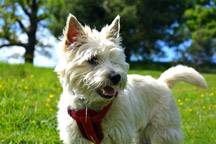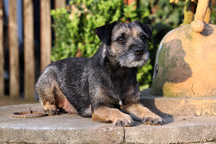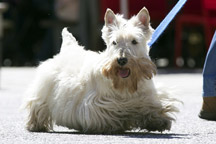Are Norwich Terriers Hypoallergenic Dogs?
110 percent! This perky and plucky pooch makes the perfect playmate for allergy sufferers!
The Hypoallergenic Norwich Terrier
Inquisitive, lovable, and spritely, the cute-as-a-(furry)-button Norwich Terrier is the consummate companion for those prospective pet parents who are sensitive to doggies.
Don’t let the fact that it has a dense coat and a fluffy face deter you!
The fur forms the character of this beloved breed and—the good news is—these doggies love it so much, they want to hold onto it.
As such, the Norwich Terrier is incredibly low shedding. Fair play, you may experience some seasonal drop in spring and fall—but forewarned is forearmed. As long as you ‘up’ your grooming game in these months, you’ll have little to no issues.
For the rest of the year, you’ll hardly notice any hair loss—a boost for those who find puppy dog fur causes sniffles and sneezes.
What’s more, the thick coat actually has a beneficial side effect for allergy sufferers. It’s so concentrated that it retains the dander. Thus, you’re going to avoid airborne and surface-sitting dead skin cells—which can cause coughs and tickles. Although, check out the grooming section below to see how to remove this ‘stored’ shedding.
Want another reason to have a Norwich Terrier?
There’s no drool! This desirable doggie doesn’t slobber—a massive bonus for people with intolerances, as the salivary proteins can induce eczema, asthma, and rashes,
Admittedly, they do like to give you a loving lick—but with a little training, you can prevent puppy dog kisses—if you want to!
The bottom line—the Norwich Terrier is a truly wondrous hypoallergenic dog.
Is the Norwich Terrier Hypoallergenic? Contents
Norwich Terrier Quick Facts
About the Norwich Terrier
Physical Characteristics and Coat of the Norwich Terrier
Norwich Terrier Temperament
Norwich Terrier Grooming and Care
Norwich Terrier Training and Exercise
Training Your Norwich Terrier
Conclusion
Norwich Terriers FAQs
Norwich Terrier Fact Summary
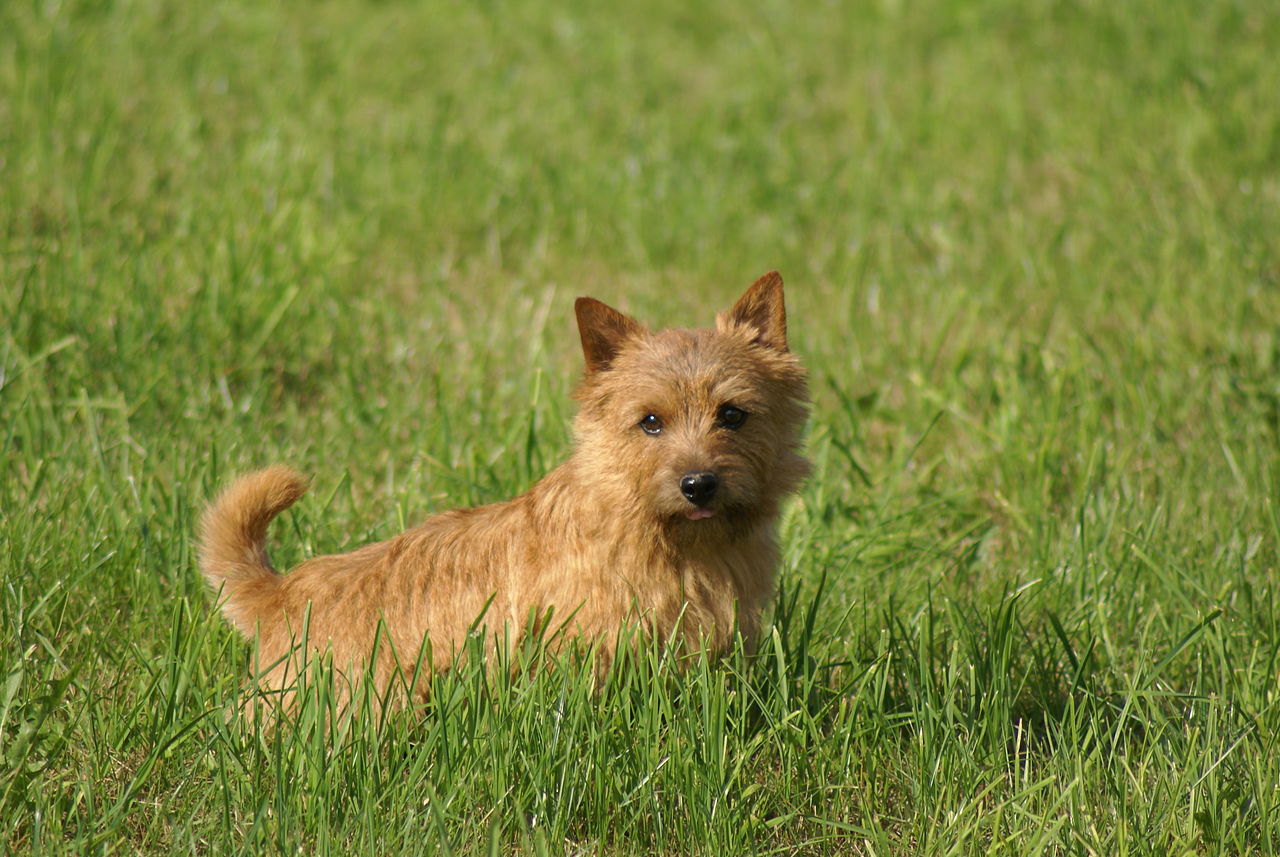
By Helene Gisin CC BY-SA 4.0
Norwich Terrier Quick Facts
| Hypoallergenic Dog: | Yes! |
| Shedding: | Extremely low |
| Drooling: | No |
| Size: | Small |
| Breed Group: | Terrier |
| Lifespan: | 12 to 15 years |
| Energy Level: | High |
| Trainability: | Easy |
| Family Dog: | Yes! |
About the Norwich Terrier
Looking at the Norwich Terrier, you’d think he’d just come from the cuddly-pal section of a toy shop.
Nothing could be further from the truth!
In actuality, this doggie is an efficient killer—one of the smallest working dogs and with a penchant for exclusive academia.
History of the Norwich Terrier
Back in the late 1800s, the UK must have had a seriously enormous rat problem.
It seems that every man (and his dog) were breeding pooches to exterminate these rodents—Cairns, Yorkshires, and West Highlands—the list goes on.
What’s more, being practical, the British didn’t waste too much time inventing breed names. Basically, they just called them after their local area.
The Norwich Terrier is no exception. It comes from Norwich, a sleepy agricultural area in the UK. And, farmers loved it for its incredibly high prey drive.
But it was in the University city of Cambridge that it started to become popular with the average Joe (well, if average means coming from an upper-class background and having an immense trust fund to pay for your education).
You see, in the early 1900s, there was no social media.
While they could have waited 100 years for it to come along, the young college students became proactive instead, and sought an alternative line of interest—Norwich Terriers.
Originally, the young erudition-seeking socialites brought these pooches into dorm rooms to cure their rat problem (yes, again). They sourced the canines from a stable on Trumpington Street—giving rise to one of the many original names—the Trumpington Terrier.
One dog in particular, Rags, was particularly frisky—siring a whole plethora of Norwich litters. Today, this turned-on terrier is thought to be the grandfather of the whole breed.
Then, the Norwich Terrier went international.
In 1910, Frank ‘Roughrider’ Jones, a British dog lover, refined the breed—eventually sending one of Rag’s descendants, Willum, to Philadelphia. This seafaring canine then fathered numerous puppies in the USA (so obviously more than one pooch must have made the trip).
Roughrider Jones explained to the Americans that this was the Norwich Terrier. The inhabitants of Philadelphia—having no idea of what, where, or who Norwich was—instead, called them the Jones Terriers.
Over the years, the breed regained its original name—well, at least some did. A quirk of nature dictated that some pups had pointy ears—while the ears of others were droopy and folded. Those with turned down lugs were called drop-eared Norwich Terriers. Eventually, they gained a new nomenclature—the Norfolk Terrier (being the county in which Norwich resides).
In 1979, the AKC (American Kennel Club) recognized that Norwich and Norfolk Terriers were separate breeds.
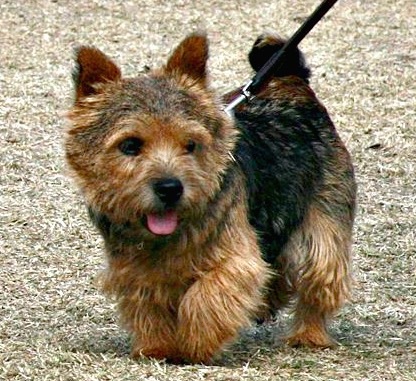
Physical Characteristics and Coat of the Norwich Terrier
Despite the fact that the Norwich Terrier is a remarkable rat eradicator—look into his face and you’d think that butter wouldn’t melt.
With deep black eyes, a furry face, a cheeky smile, and alert pointy ears, it appears as if God (or another deity of your choice) opened up the ‘serious cuteness’ drawer when he (or she) put this doggie together.
Furthermore, the creator (or the big bang) decided that this would be a completely compact canine. Being around 10 inches high and with a stocky body, the Norwich Terrier is built for concentrated prey-killing power—but equally for cuddling up nicely on your lap.
These doggies always look happy—a countenance that’s reinforced by its constantly wagging tail. And, depending on the lineage, this can be as short as two inches, through to an incredibly long (for its size) eight inches.
The Norwich Terrier’s coat is wiry, a little rough—and almost completely waterproof—lying near to its body with a dense undercoat. On its adorable head, the hair is smooth and short—although with expressive Roger Moore-type eyebrows.
Generally, the coat will grow to about three inches—and while you will need to look after it with a little grooming—it’s nothing that should deter prospective parents.
Typically, the Norwich Terrier sports one of the following coat colors:
- Black and tan.
- Grizzle.
- Red.
- Wheaten.
If you’re showing your Norwich Terrier, white markings are frowned upon by the strict canine clubs. However, due to this doggie’s inquisitive, exploratory, and adventurous nature, hunting scars aren’t penalized.
Norwich Terrier Temperament
The Norwich Terrier has an angel on one shoulder and a devil on the other.
On the cherubic side, they’re happy-go-lucky, with an optimistic outlook on life. They adore both giving and receiving love—and will take any opportunity to give you attention and cuddles.
As a pack dog, they absolutely thrive on human interaction—and the more you focus on them, the more loyal they become. Admittedly, this can lead to them being protective of you around strangers—but once introduced to these new and unusual creatures, they will act like their best friend too.
As a family dog, Norwich Terriers are ideal—they love playing with kids and, due to their robust nature, they will stand a fair amount of rough and tumble. Furthermore, they mix well with other dogs and—indeed—cats.
However, be careful—this is where the devil can creep in.
If you have small rodents as house companions (like hamsters and gerbils—or rats), the Norwich terrier will not see them as a playmate—but as a meal. Being primarily a working dog—when it spots smaller creatures, its hunting instinct will kick in.
They can also be somewhat bossy and demanding. Being patient with your training can cure this issue—so don’t give in. The Norwich Terrier knows it has the cutest face in the world—and will use this to its advantage in trying to manipulate you—often in the pursuit of treats.
Bear in mind that while they may sometimes act as independent,if they lack company they will suffer from separation anxiety.
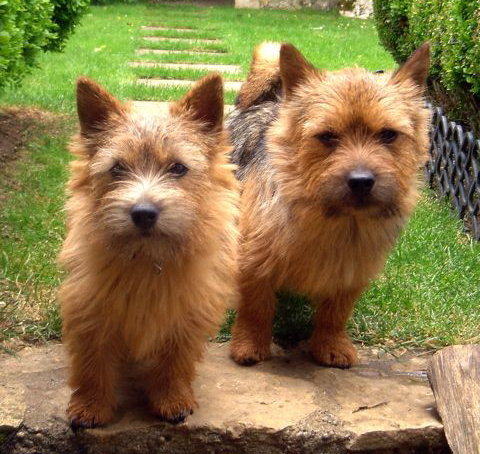
Norwich Terrier Grooming and Care
Looking After Their Coat
Not everyone has the time or inclination for elongated grooming sessions—and with the Norwich Terrier, luckily that’s not required. However, it’s not a case of leaving the coat to run riot—there are some crucial areas that will need your attention.
In the shedding season of fall and spring, the Norwich Terrier needs hand-stripping, which is something that can scare the bravest of pet parents.
From being children, we’ve all been taught not to pull someone else’s—or a dog’s—hair. Yet this procedure requires you to pluck out your pooch’s dead coat, necessary to prevent future shedding and allow new growth to come through.
If you’ve never done this before—or just don’t fancy the job—then take your doggie to a professional dog groomer. Alternatively, consider a different breed of small hypoallergenic pup.
On a weekly basis, a couple of brushing sessions per week will be sufficient. However, Norwich Terriers do love this attention, so there’s nothing stopping you from giving him or her a daily beauty session—it can be quite therapeutic for you too!
That said, there are occasions when you’re required for some ad-hoc grooming.
As adventurous pooches, they will put on their explorer’s hat during any outside time—and take every opportunity to dig, roll in the grass, and plow through the undergrowth. Meaning that your post-stroll procedures may necessitate a quick shower.
Wherever possible, you should avoid taking clipping to the max, or going for a puppy cut.
While you may be considering it as a time-saving and maintenance-easing idea, you will destroy the beautiful texture and colors of your doggie’s coat. Furthermore, you want to retain your Norwich Terriers off-the-scale cuteness—and part of that is their delightful fur.
Teeth and Nail Care of the Norwich Terrier
There’s no special attention required here. Simply ensure that you regularly trim the nails to prevent splitting—usually no more than once every two weeks.
For their gnashers, give them a good clean 2-3 times a week, with some specialty dog toothpaste.

Norwich Terrier Training and Exercise
If you live in an apartment, the Norwich Terrier can be the ideal companion. Being compact and bijou, they’re not going to take up much space.
However, this doesn’t mean they should be housebound.
These doggies are lively and energetic, and they need stimulation. Meaning that daily walkies are essential. At the very least, you will need to take your Norwich Terrier outside for a couple of 20-25-minute strolls—although they will eagerly do more.
Having an outside garden or yard area is a big bonus. They will happily invent their own games—and it’s not unusual to see them chasing around in pursuit of imaginary prey.
However, ensure your outdoor area has strong boundary fences or walls.
If your Norwich Terrier spots any prospective prey, it will shoot off in hot pursuit. It may appear like a lap dog in your home—but outside it’s a hunting machine. It’s perhaps even more crucial to bear this in mind if you’re out in a field or park—let your pooch off the leash and its animal-catching time.
Similar Dog Breeds To Norwich Terrier
And, you can also play indoors.
If your pup has already completed their daily walk quota but they’re still bouncing around your apartment like a hyperactive child, amuse your Norwich Terrier with some tug-of-war.
Training Your Norwich Terrier
Remember the angel and devil? Well, they’re back when it’s time for training your Norwich Terrier.
When these doggies are wearing their halos, they’re eager to please—wanting your praise and appreciation. As such, this can make them fast and willing learners—often meaning easy training.
However, sometimes their devilish nature can emerge.
This means that, at times, they can develop a manipulative nature—demanding more and more treats to ‘perform.’
And this can be an issue.
These pooches pile on the pounds seriously easily—and they’ll keep knocking back the doggie sweets without a care for their waistline. So, you should use an alternative reward system, such as giving them their favorite toy or cuddly as a prize. Or simply shower them with oodles of praise.
I recommend early socialization—with other dogs, cats, children, and humans. Starting from puppyhood means that your Norwich Terrier will grow into a well-tempered and accepting dog.
And—to cover the bases of both training and exercise—involve your fur baby in sports.
Norwich Terriers love—and are extremely adept at—canine Olympics, such as the barn hunt, earthdog, agility, flyball, and obedience.
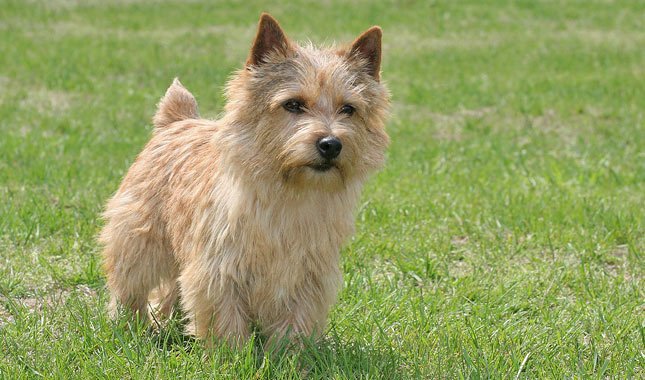
Norwich Terrier Health Issues
Responsible Norwich Terrier breeders complete preventive health testing—meaning that the breed doesn’t suffer from too many illnesses or complications. However, there are some issues that a prospective pet owner should be aware of:
Conclusion
With its lively personality, an eagerness to please, total loyalty, and heart-melting eyes, the Norwich Terrier makes an ideal family member.
They mix incredibly well with children, make friends with other four-legged animals (unless they’re rodents) and can be a perfect apartment pooch.
However, being highly energetic, you will need to ensure your Norwich receives enough exercise—otherwise be prepared for vocal protestations! Furthermore, watch the treats—as this manipulative mutt will trick you into over-rewarding—and weight gain!
Most importantly—these doggies are wonderful for allergy sufferers.
Low shedding, producing hardly any dander, and no drooling or slobbery issues—the Norwich Terrier hypoallergenic hound is unlikely to induce coughs and sneezes.
Norwich Terriers FAQs
Do Norwich Terriers Bark a Lot?
Norwich Terriers aren’t overly vocal pooches—although in some circumstances they can create some noise.
If left without company for extended periods, they could become frustrated and lonely, emotions that they will express through barking.
Furthermore, being protective, they may become vocal around strangers. But, once you introduce them, this will usually cease.
Are Norwich Terriers Expensive?
Highly desirable, these doggies can be a little hard on the bank balance.
A Norwich Terrier currently costs around $2000-$4000. And, should you go for a superior pedigree or important bloodline, the price may be in the region of $5000-$6000.
Are Norwich Terriers Good Pets?
Undoubtedly! They will shower you with love, adore children, and can adapt well to apartment life—as long as they have sufficient walking sessions.
Furthermore, being hypoallergenic, they’re ideal for people who find that doggie fur causes sneezes and coughs.
Can Norwich Terriers Be Left Alone?
As pack dogs, Norwich Terriers don’t respond well to being on their own. Although unlikely to chew, they will likely become highly vocal and distressed.
These pooches thrive on human interaction. Hence, if you work, or hobbies dictate you will be frequently leaving your pooch on its lonesome, this breed isn’t recommended.
Do Norwich Terriers Shed?
Norwich Terrier shedding is minimal.
Although they will lose some seasonal fur in spring and fall, for the rest of the year, their coat is unlikely to drop much hair.
This means that the Norwich Terrier is ideal for prospective pet parents with allergies.
Is the Norwich Terrier Small?
An adult Norwich Terrier measures around 10 inches at its shoulder, and weighs about two pounds.
What Is the Lifespan of a Norwich Terrier?
On average, the Norwich Terrier will live for 12-15 years, although there are many instances where they have lived for much longer.
How Much Exercise Does a Norwich Terrier Need?
As a lively and energetic pooch, a Norwich Terrier requires walking twice daily—for around 20-25 minutes each time.
Additionally, they will welcome a couple of 10-15 minute play sessions in your home.
How Do You Groom a Norwich Terrier?
To keep your Norwich Terrier in top condition, you should pass a brush through its coat at least twice a week.
Furthermore, in spring and fall, the coat will need hand-stripping. If you haven’t done this in the past, it’s advisable to seek the help of a professional dog groomer—or sign up for a class in this skill.
Do Norwich Terriers Like to Swim?
Norwich Terriers love water and enjoy nothing more than a swim in summer. However, never leave your pooch unattended when in the water, as they may struggle when trying to climb out.
Norwich Terrier Fact Summary
| Breed | Norwich Terrier |
| Other Names | Trumpington Terrier, Cantab Terrier, Jones Terrier, Prick-Eared Norwich Terrier |
| Height | 10 inches (25.4 cm) |
| Weight | 2 pounds (5.44 kg) |
| Lifespan | 12 to 15 years |
| Temperament | Affectionate, energetic, hardy, inquisitive, intelligent, fun-loving, and attention-seeking |
| Colors | Black and tan, grizzle, red, and wheaten |
| Coat | A wiry and shaggy top coat, with a dense undercoat |
| How much grooming? | Needs hand-stripping twice per year. Companion pooches will be fine with a couple of grooming sessions per week, while competition dogs will need daily attention. Ideally, don’t opt for a puppy-cut as this ruins the characteristic texture and color of the Norwich Terrier |
| How much shedding | Minimal. This dog will shed a negligible amount. Recommended for owners who do not want to deal with dog hair in their cars and homes |
| Dander levels | Low |
| Saliva – Do they drool or lick much? | Low – not a breed known to be prone to drool or slobber |
| Energy levels | High |
| How much exercise do they need? | At least two 20-25 minutes walk per day—plus a session of indoor playtime |
| Health problems | Although generally a healthy pooch, they can be prone to hip dysplasia, mitral valve disease, and progressive retinal atrophy |
| Good for an apartment? | Excellent, due to the Norwich Terrier size—but still require daily walkies |
| Suitable for kids? | Ideal! They love children and adore playing |
| How much do they bark? | Minimal. They will bark when left alone or if wary of strangers |
| Can they be left alone? | No. They thrive on human interaction and will suffer from separation anxiety if left alone for extended periods |
| Intelligent? | Yes |
| Trainable? | Yes—but reward with praise and toys, not treats, as they pile on the pounds very quickly |
| Interesting Fact | The movie comedy, Best In Show (2000), featured a real-life, show-winning Norwich Terrier called Winky. |
| How popular as a pet? | Somewhat—ranked 108th out of 195 breeds by the American Kennel Club. Additionally, the Norwich Terrier Hypoallergenic characteristics make them popular with allergy sufferers. |



